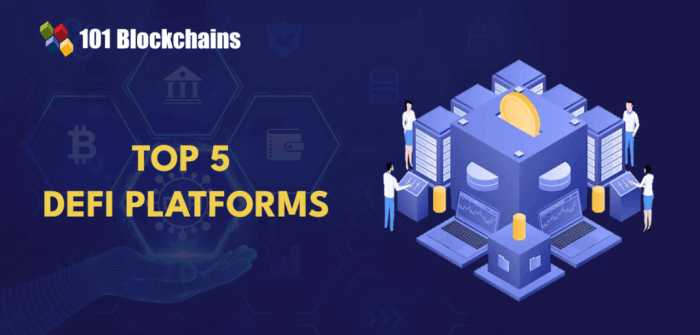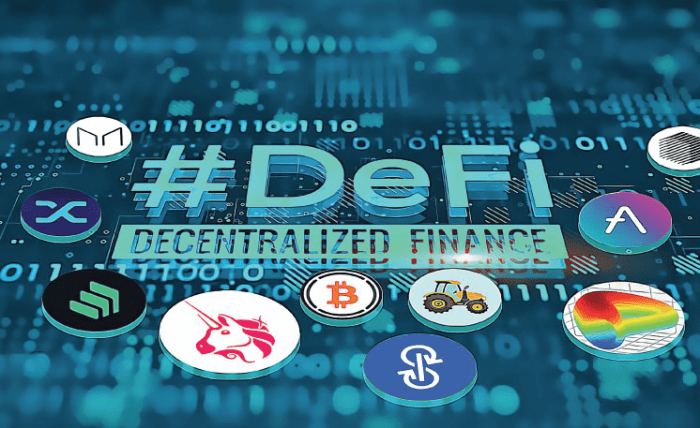As DeFi platforms take the spotlight, get ready to dive into a world where cryptocurrency meets innovation. Explore how these platforms are reshaping traditional finance and redefining user experiences in the digital realm.
From the technology powering DeFi to the unique services offered, this overview will give you a comprehensive look at the exciting landscape of decentralized finance platforms.
What are DeFi platforms?
DeFi platforms, short for Decentralized Finance platforms, are blockchain-based financial services that allow users to access a variety of financial products and services without the need for traditional intermediaries like banks or brokers. These platforms aim to provide a more open, transparent, and inclusive financial system for everyone.
Purpose of DeFi platforms
DeFi platforms enable users to engage in activities such as lending, borrowing, trading, and earning interest on their cryptocurrency assets. These platforms leverage smart contracts and decentralized applications (dApps) to automate processes and eliminate the need for third-party intervention, providing users with greater control over their funds.
- Access to a wide range of financial services
- Greater financial inclusion for individuals worldwide
- Transparency and security through blockchain technology
Difference from traditional financial systems
DeFi platforms differ from traditional financial systems in that they operate on a decentralized network, removing the reliance on centralized authorities. This decentralization eliminates the need for intermediaries, reduces costs, and increases accessibility for users globally.
- Peer-to-peer transactions without intermediaries
- No geographical restrictions for users
- 24/7 availability for trading and other services
Benefits of using DeFi platforms
Using DeFi platforms offers several benefits for users, including lower fees, faster transactions, increased privacy, and access to a wider range of financial products. Additionally, DeFi platforms provide users with the opportunity to earn passive income through various cryptocurrency-based activities.
- Lower transaction fees compared to traditional financial services
- Fast and efficient cross-border transactions
- Increased privacy and security of financial data
Popular DeFi platforms
Some of the popular DeFi platforms in the market include:
Uniswap, Compound, Aave, MakerDAO, and SushiSwap.
These platforms offer a diverse range of services such as decentralized trading, lending, borrowing, and yield farming, catering to the diverse needs of cryptocurrency users in the DeFi space.
How do DeFi platforms work?

DeFi platforms operate on blockchain technology, allowing users to access financial services without the need for traditional intermediaries like banks. These platforms leverage smart contracts to automate processes and enable activities such as lending, borrowing, and trading in a decentralized manner.
Underlying Technology
Blockchain technology serves as the foundation of DeFi platforms, providing a secure and transparent way to record transactions. The use of distributed ledger technology ensures that all transactions are immutable and verifiable by all participants in the network.
Smart Contracts in DeFi
Smart contracts are self-executing contracts with the terms of the agreement directly written into code. In DeFi platforms, smart contracts facilitate automated transactions without the need for intermediaries, ensuring trustless and efficient operations for users engaging in various financial activities.
Interacting with DeFi Platforms
To engage with DeFi platforms, users typically connect their cryptocurrency wallets to the platform using a secure connection like MetaMask. Once connected, users can participate in lending their assets to earn interest, borrowing funds by providing collateral, or trading various digital assets on decentralized exchanges within the platform.
Security Features in DeFi Platforms
DeFi platforms implement various security measures to protect user funds, including multi-signature wallets, audits of smart contracts, and decentralized governance mechanisms. These features aim to minimize the risk of hacks or unauthorized access to user funds, enhancing the overall security of the platform for users.
Types of DeFi platforms
When it comes to DeFi platforms, they can be classified based on their primary functions, such as lending, decentralized exchanges, and derivatives. Each type offers unique advantages and disadvantages, catering to different user needs and preferences.
Lending Platforms
Decentralized lending platforms allow users to lend their cryptocurrencies to earn interest or borrow assets by providing collateral. One of the main advantages of these platforms is the ability to earn passive income through lending. However, the risk of smart contract vulnerabilities and potential liquidation of collateral are some of the disadvantages associated with decentralized lending.
Decentralized Exchanges (DEX)
Decentralized exchanges enable users to trade cryptocurrencies directly with one another without the need for intermediaries. The main advantage of DEXs is the high level of security and privacy they offer, as users retain control of their funds throughout the trading process. On the downside, decentralized exchanges may face issues such as low liquidity and slower transaction speeds compared to centralized exchanges.
Innovative DeFi Platforms
Some DeFi platforms are pushing the boundaries by offering unique services that go beyond traditional lending and trading. For example, platforms like Yearn Finance automate the process of yield farming, allowing users to maximize their returns with minimal effort. Another example is Uniswap, a decentralized exchange that introduced the concept of automated market makers, revolutionizing the way trades are executed on DEXs.
DeFi platform trends and challenges

Cryptocurrency and DeFi platforms have been experiencing rapid changes and facing various challenges in the financial landscape. Let’s delve into the current trends and obstacles in the DeFi platform space.
Yield Farming and Liquidity Mining
Yield farming and liquidity mining have become popular trends in the DeFi space. Yield farming involves earning rewards by providing liquidity to DeFi protocols, while liquidity mining incentivizes users to participate in these platforms by offering tokens as rewards. These practices contribute to the growth of DeFi platforms but also come with risks such as impermanent loss and smart contract vulnerabilities.
Scalability Challenges
One major challenge faced by DeFi platforms is scalability. As more users engage with these platforms, issues like high transaction fees and network congestion arise. To address this, DeFi projects are exploring solutions like layer 2 scaling solutions, such as sidechains and rollups, to improve scalability and enhance user experience.
Regulatory Challenges and Compliance Issues
DeFi platforms operate in a regulatory grey area, which poses challenges in terms of compliance with traditional financial regulations. Regulatory uncertainty and potential crackdowns in different jurisdictions create obstacles for DeFi projects looking to operate legally. Compliance issues, such as anti-money laundering (AML) and know your customer (KYC) requirements, also present challenges for DeFi platforms to navigate.
Future Outlook and Growth Opportunities
Despite the challenges, the future outlook for DeFi platforms remains promising. Innovations in decentralized finance continue to drive growth and development in the space. Areas such as decentralized exchanges (DEXs), synthetic assets, and decentralized lending are expected to expand further, offering new opportunities for users to participate in the DeFi ecosystem. As the industry matures, collaboration with regulators and the adoption of compliance measures will be crucial for the sustainable growth of DeFi platforms.
